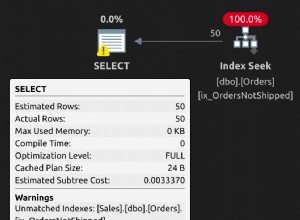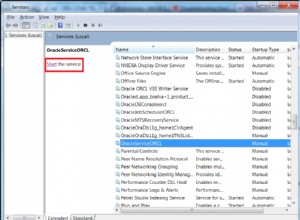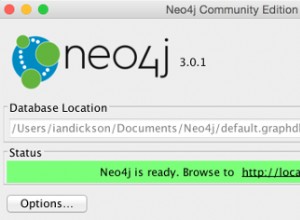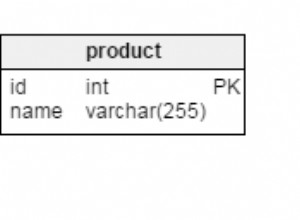Sie könnten, wie Sie sagten, eine Tabelle haben, die alle Primzahlen bis zu 10 Millionen speichert . Dann wäre es trivial nachzuschlagen, ob eine Zahl eine Primzahl ist oder nicht. Die Frage ist dann, welche Methode schneller wäre. Ich vermute, die Tabelle wäre viel schneller (ich habe diese Behauptung nicht getestet).
Prime-Tabellenlösung
-
https:// www.simple-talk.com/sql/t-sql-programming/celkos-summer-sql-stumpers-prime-numbers/
Stellt ein paar Lösungen bereit und es gibt mehr in den Kommentaren. -
https:// sqlserverfast.com/blog/hugo/2006/09/the-prime-number-challenge-great-waste-of-time/
Auch hier. Ein paar Lösungen bereitgestellt.
SQL-Funktionslösungen
Lösung 0Hier ist eine Lösung über Primzahlen mit einer Transact-SQL-Funktion finden :
SET ANSI_NULLS ON
GO
SET QUOTED_IDENTIFIER ON
GO
–- =============================================
–- Author: Nicolas Verhaeghe
–- Create date: 12/14/2008
–- Description: Determines if a given integer is a prime
/*
SELECT dbo.IsPrime(1)
SELECT dbo.IsPrime(9)
SELECT dbo.IsPrime(7867)
*/
–- =============================================
CREATE FUNCTION [dbo].[isPrime]
(
@NumberToTest int
)
RETURNS bit
AS
BEGIN
-– Declare the return variable here
DECLARE @IsPrime bit,
@Divider int
–- To speed things up, we will only attempt dividing by odd numbers
–- We first take care of all evens, except 2
IF (@NumberToTest % 2 = 0 AND @NumberToTest > 2)
SET @IsPrime = 0
ELSE
SET @IsPrime = 1 –- By default, declare the number a prime
–- We then use a loop to attempt to disprove the number is a prime
SET @Divider = 3 -– Start with the first odd superior to 1
–- We loop up through the odds until the square root of the number to test
–- or until we disprove the number is a prime
WHILE (@Divider <= floor(sqrt(@NumberToTest))) AND (@IsPrime = 1)
BEGIN
–- Simply use a modulo
IF @NumberToTest % @Divider = 0
SET @IsPrime = 0
–- We only consider odds, therefore the step is 2
SET @Divider = @Divider + 2
END
–- Return the result of the function
RETURN @IsPrime
END
Hier ist eine weitere Lösung über Wie finde ich mit einer select-Anweisung heraus, ob es sich um eine Primzahl oder eine Nicht-Primzahl handelt? Es gibt auch weitere Informationen in anderen Kommentaren.
CREATE FUNCTION isPrime
(
@number INT
)
RETURNS VARCHAR(10)
BEGIN
DECLARE @prime_or_notPrime INT
DECLARE @counter INT
DECLARE @retVal VARCHAR(10)
SET @retVal = 'FALSE'
SET @prime_or_notPrime = 1
SET @counter = 2
WHILE (@counter <= @number/2 )
BEGIN
IF (( @number % @counter) = 0 )
BEGIN
set @prime_or_notPrime = 0
BREAK
END
IF (@prime_or_notPrime = 1 )
BEGIN
SET @retVal = 'TRUE'
END
SET @counter = @counter + 1
END
return @retVal
END




